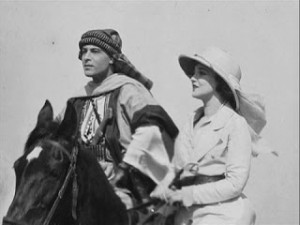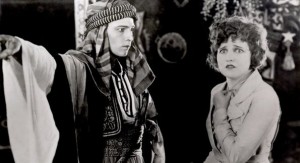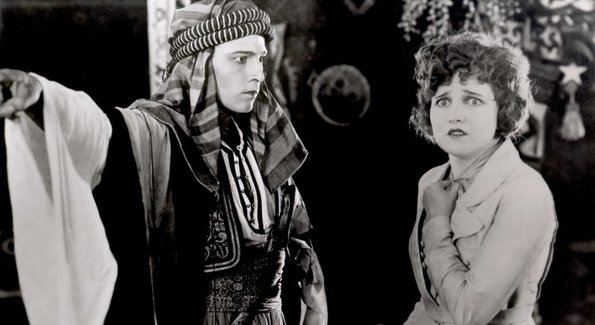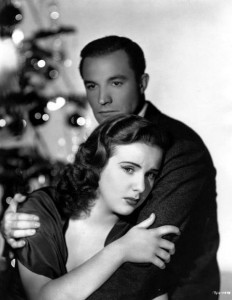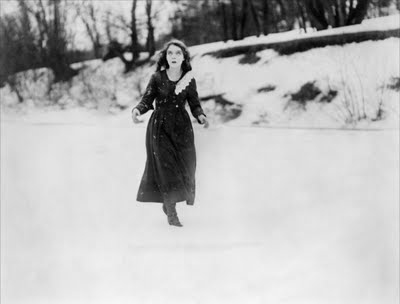Posted by Sarah
We started with an introduction to the film and its significance for the group’s interest in melodrama research.
The Sheik (George Melford, 1921) is clearly very different from the thrilling ‘suspense melodrama’ The Narrow Margin (Richard Fleischer, 1952) which we screened a fortnight ago. I feel, however, discussion on genre definitions follows on from that session quite nicely. To recap, last time we looked at Steve Neale’s work on melodrama definitions. He noted that in the 1930s and 1940s the term ‘melodrama’ was used by the trade press to describe films which we might now refer to as film noir. Such films included elements of ‘action, adventure and thrills’ and predominately belonged in the genres of war, adventure, horror and thriller (1993, p. 69). These were ‘traditionally thought of as, if anything, “male”’ (ibid) . This is quite different to how the 1970s feminist film academics (notably Laura Mulvey 1963 and 1986 and Christine Gledhill 1987) and other writers on film melodrama used it. Their definition of melodrama was closely tied to melodrama’s rejection of realism, its relation to the ‘woman’s film’, and its debt to Victorian theatrical melodrama (Neale, 1993, pp. 66-7).
I have found the definition used by the American Film Institute (the AFI) useful, even though it is of course retrospectively fitted to films. This is because it ties in well with what most people would understand the term ‘melodrama’ to mean. The AFI defines melodramas as ‘fictional films that revolve around suffering protagonists victimized by situations or events related to social distinctions, family and/or sexuality, emphasizing emotion’. (http://afi.chadwyck.com/about/genre.htm)
While The Sheik is not categorised as melodrama by the AFI I have chosen it for several reasons. Firstly my research focuses on Hollywood stars, although admittedly mostly star couples, and Valentino was a huge star. This film ‘made him’ as it was very popular. Emily W Leider in Dark Lover: The Life and Death of Rudolph Valentino (2004) notes that the film broke attendance records at two major New York theatres (The Rialto and the Rivoli) and that the New York Telegraph estimated that in the first few weeks 125,000 people had seen the film (p. 154). The Sheik was also popular abroad. It was in circulation in Sydney for six months, and ran for 42 weeks at a theatre in France (ibid). Within its first year it grossed $1m worldwide, having cost just $200, 000 to make (ibid).
I also think the fact The Sheik was produced in 1921 is important. During 1921, according to my trawling of the AFI catalog, there was a huge upsurge in the number of film melodramas produced in the US. In 1920 melodramas accounted for 1.75% of films produced in the US. By 1921 the figure was 49.63% – very nearly half of all US productions. In addition, by 1922, according to figures compiled by Mark Purcell and quoted by Richard Koszarski in his contribution to The History of the American Cinema series, half of the top 10 box office hits were melodramas (p. 33). The melodramas (according to the AFI) were: 2: D.W. Griffith’s Orphans of the Storm –starring the Gish sisters, 3: John S Robertson’s Tess of the Storm Country starring Mary Pickford, 5: Frank Lloyd’s adaptation of Charles Dickens’ Oliver Twist starring Jackie Coogan and Lon Chaney 8: D. W. Griffith’s One Exciting Night, 9: Von Stroheim’s Foolish Wives. (As a side note Fred Niblo’s Blood and Sand starring Valentino was no. 4. Although this was given the broader category of drama by the AFI.) Melodramas weren’t just being produced in large numbers then, but attracting huge audiences too. I’m intrigued as to why they exploded at this point, since films had become feature length some time earlier. It wasn’t the case that they only became able to relate complex melodramatic plots to an audience. I am particularly interested in film melodrama’s relation to stage melodrama, literature, and other social and cultural factors of the period.
References
Gledhill, Christine. Home is where the Heart is: Studies in Melodrama and the Woman’s Film. British Film Inst, 1987.
Koszarski, Richard. An evening’s entertainment: The age of the silent feature picture, 1915-1928. Vol. 3. University of California Press, 1994.
Leider, Emily W. Dark lover: the Life and Death of Rudolph Valentino. Farrar Straus & Giroux, 2004.
Mulvey, Laura. Notes on Sirk and melodrama. 1963. (Reprinted in Gledhill, 1987).
Mulvey, Laura. “Melodrama in and out of the home.” High Theory/Low Culture: Analyzing Popular Television and Film (1986).
Neale, Steve. “Melo Talk: On the Meaning and Use of the Term ‘Melodrama’ in the American Trade Press.” Velvet Light Trap 32 (1993): 66-89.
Discussion after the screening
The discussion ranged widely and included: the fact that both protagonists suffered; the romantic comedy elements of The Sheik– especially in relation to the possible categorisation of the film as melodrama; the film’s interesting gender politics – particularly in reference to ‘Stockholm Syndrome melodrama’ and racist overtones; acting styles and melodrama.
Further reading
Hansen, Miriam, and Miriam Hansen. Babel and Babylon: spectatorship in American silent film. Harvard University Press, 1991.
Studlar, Gaylyn. This Mad Masquerade: Stardom and Masculinity in the Jazz Age. Columbia University Press, 1996.
If anyone would like to take these thoughts further, or mention anything omitted here (or indeed anything else melodrama-related), please comment or email me on sp458@kent.ac.uk
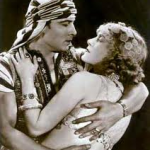 This too starred Rudolph Valentino, this time in dual roles. As The Sheik (married to Lady Diana of the first film, again played by Agnes Ayres) and the Sheik’s son. The son’s love interest is played by Vilma Banky.
This too starred Rudolph Valentino, this time in dual roles. As The Sheik (married to Lady Diana of the first film, again played by Agnes Ayres) and the Sheik’s son. The son’s love interest is played by Vilma Banky.
